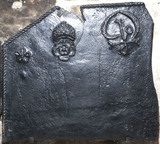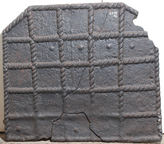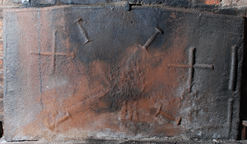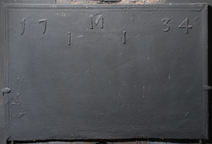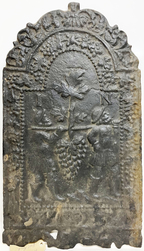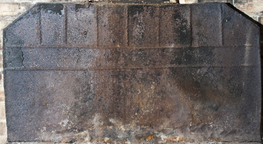-
1110
Description: Fragment; canted rectangular shape; twisted rope edging (top and sides); top right (i.e. probably top centre), unidentified (apparently inverted) ornamental capital letter 'T'; top left, a triple-loop fleur stamp; between, rose and crown.
Notes: Probably slightly more than half of the original fireback, with stamps also seen on another, commonly copied, fireback. It might reasonably be supposed that the missing half may have also included an ornamental letter, companion to the surviving example. Formerly at Bentley, Halland, Sussex.
- Decoration tags:
- canted rectangular (shape)
- rope (edging)
- simple stamps
- carved stamps
- heraldic
Manufactured: in the late 16th century in the Weald area of England.
Current location: in private hands, Crowborough, East Sussex, England.
Citation: Fitt, H. F., 1931, 'Queries: Sussex Iron, II', Sussex Notes and Queries, 3, 8, p. 255.
- Attached to series:
- Looped fleur series
-
363
Description: Arched rectangular shaped, the arch linked to the rectangle by cavetto curves; cavetto edging ending in two opposed spirals at top; initials below spirals; date below initials; otherwise plain.
Notes: Probably cast from a carved, edged board, with the initials and date added separately.
Inscription: I or F H / 1698
- Decoration tags:
- arched rectangular (shape)
- carved stamps
- individual letters
- individual numbers
- text
Manufactured: in 1698 in the Weald area of England.
Current location: Scotney Castle, Lamberhurst, Kent, England.
Museum number: 791911 (part of the National Trust museum group)
- Attached to series:
- Small arch series
- Date & initials firebacks
-
461
Description: Canted rectangle; twisted rope edging; irregularly spaced, 5 x 5 rope grid; damage to top right corner.
Notes: A 5 x 3 variant is also known.
- Decoration tags:
- canted rectangular (shape)
- rope (edging)
- simple stamps
- objects
Manufactured: in the mid to late 16th century in the Weald area of England.
Current location: Anne of Cleves House, Southover High Street, Lewes, East Sussex, England.
Museum number: 1944.24.046 (part of the Sussex Archaeological Society museum group)
- Attached to series:
- Rope design firebacks
-
587
Description: Quasi-rectangular; grooved dowel edging (top and sides); four impressions of a rondel dagger (c.330mm) saltirewise between two dowel crosses; two vertical lengths of dowel in line along right edge.
Notes: Rondel daggers were common in the 15th and 16th century. Grooved lengths of dowel are to be seen on other firebacks suggesting a common source. The arrangement of the daggers (each approx. 35cm long) in a saltire may also have apotropaic significance.
- Decoration tags:
- quasi-rectangular (shape)
- grooved dowel (edging)
- simple stamps
- apotropaic
- objects
Manufactured: in the mid 16th century in the Weald area of England.
Current location: in private hands, Plaxtol, Kent, England.
- Attached to series:
- Grooved dowel series
- Knife & Dagger stamp firebacks
-
961
Description: Rectangular; ogee-moulded edging on top and side edges; symmetrical layout of date and initials; date split between left and right sides, initials in centre, arranged in triad.
Notes: One of a series of backs dating to the 1730s and 40s using very similar sets of letters and numerals.
Inscription: 17 I M I 34
- Decoration tags:
- rectangular (shape)
- ovolo (edging)
- carved stamps
- individual letters
- individual numbers
- text
Manufactured: in 1734 in the Weald area of England.
Current location: in private hands, Titsey, Surrey, England.
- Attached to series:
- Date & initials firebacks
- 1730s-40s, date & initial series
-
1274
Description: Arched rectangular central panel with bead edging; image of two helmeted men in 17th century dress, on a ground, carrying a huge bunch of grapes slung from a pole between them, behind are vine leaves; the initials located below the top corners; arched rectangular border, fillet edging, containing vine leaves and grapes; above, symmetrical swirling foliage descending from a scallop shell; bottom of the image obscured by corrosion damage.
Notes: The scene, drawn from the Old Testament, represents Joshua and Caleb carrying the bunch of grapes from the valley of Eshcol in the land of Canaan, back to Moses and the children of Israel (Numbers 13: 23-4); a popular subject on a variety of media in the period.
Inscription: I N
Manufactured: in the mid to late 17th century possibly in the Siegerland area of Germany.
Current location: Victoria and Albert Museum, Cromwell Road, Kensington and Chelsea, London, England.
Museum number: M.372-1912 (part of the Victoria & Albert Museum museum group)
- Attached to series:
- Joshua and Caleb firebacks
- Old Testament & Apocrypha firebacks
-
1280
Description: Canted rectangular shape; twisted rope edging (top and sides); two approximately parallel horizontal lines of twisted rope across the upper centre; from the upper line and starting at the top corners, seven regularly spaced vertical lines of twisted rope extending to the top edge.
Notes: A simple rope design without apotropaic significance.
Copies of this fireback are known.
- Decoration tags:
- canted rectangular (shape)
- rope (edging)
- simple stamps
- objects
Manufactured: in the late 16th to early 17th century possibly in the Weald area of England.
Current location: in private hands, Wadhurst, East Sussex, England.
- Attached to series:
- Rope design firebacks
